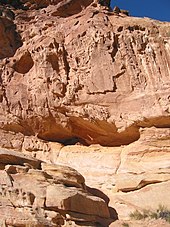Fremont culture
The Fremont culture emerged around the year 400 in an area that spanned parts of what is now the US states of Utah , eastern Nevada , western Colorado, and southern Idaho . Common features of the Fremont culture were the cultivation of corn, adobe architecture, pit houses and ceramics. The culture takes its current name from the Fremont River in Utah.
The Fremont supplemented the cultivation of corn, beans and pumpkins along watercourses with hunting and gathering. They kept their grain in storerooms high on rock faces. This, as well as the protected location of the settlements, indicates violent conflicts, for example over scarce supplies. The Fremont left numerous rock carvings.
To the southwest of the Fremont culture existed the neighboring Anasazi culture.
Since the bearers of the Fremont culture belonged to different ethnic groups and lived in different habitats, there were many regional varieties. Some of them were:
- Parowan-Fremont: 900–1250 in southwestern Utah, with strong Anasazi influence.
- Sevier-Fremont: 870–1250 in western Utah and eastern Nevada, with seasonal settlements and smaller communities.
- Great-Salt-Lake-Fremont: 400–1350 with a predominance of hunting and gathering over horticulture.
- Unita-Basin-Fremont: 650–950 in northeastern Utah with less horticulture.
- San-Raphael-Fremont: 700–1250 in eastern Utah and western Colorado, great importance of corn cultivation.
At the end of the 14th century, a devastating drought that made maize cultivation impossible ended the Fremont culture. At the same time, advancing Nun groups, ancestors of today's Shoshone and Comanche , displaced the surviving bearers of the Fremont culture from the Great Basin .

